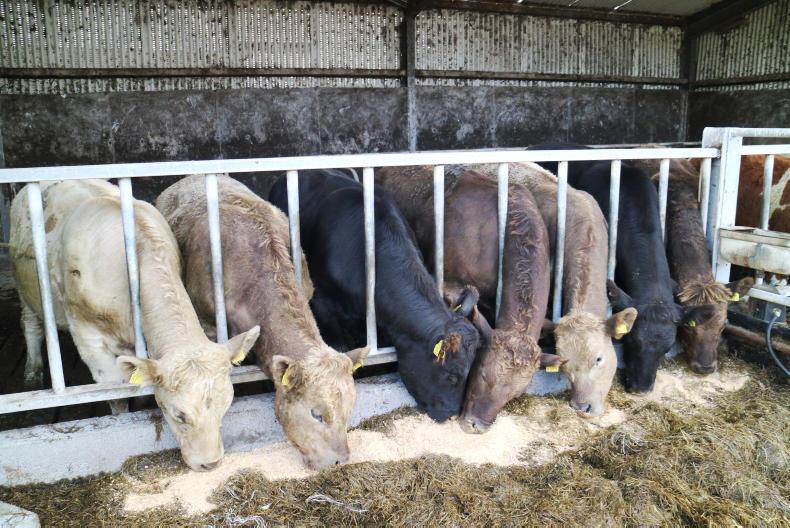Merchants throughout the country continue to report high demand for concentrates. This is being driven by earlier housing in some areas and farmers taking steps to stretch out existing fodder supplies to ensure they have enough feed to bring them through to next spring.
An Irish Farmers Journal survey on beef nut prices shows a large variation in quotes throughout the country. Costs were sought for a lower protein ration of 14% and a higher protein growing ration of 16%. The majority of prices were for bulk orders collected out of the yard.
For a 14% to 15% beef nut, there was a variation of €54/t between the highest and lowest prices quoted. The lowest quote came in Kildare for a 15% nut which costs €230/t. In comparison, the highest price came in Galway where the quote was €284/t. However, it should be noted that this quote was for small bags, as bulk were unavailable from the merchant.
There is generally a saving of anywhere from €10/t to €20/t, or even greater, when purchasing in bulk form.
Merchants in Cork, at €233/t for a 14% nut, and Kerry, at €245/t for a 15% nut, were the next lowest quotes. Merchants in Wexford and Tipperary quoted €265/t for a 14% nut, while the second-highest price was €280/t for a 14% nut in Sligo. Merchants in the west will point towards the higher delivery charges as the reason for higher quotes.
High protein
A higher protein nut of 16% to 17% protein was recommended by the majority of merchants as the best seller for a growing ration.
Again, a large range was seen in prices quoted, with a Kildare merchant providing the lowest quote at €245/t, followed closely by a Galway merchant at €250/t.
Next in line was a Cork merchant at €261/t for a 17% protein nut.
A merchant in Wexford quoted €275/t for a 16% protein nut, while this rose to €285/t in Kerry. Again, the highest quote received was from Sligo, where a 16% protein nut is costing farmers €290/t.
Merchants are also keen to point out that the difference in price is, in some cases, down to the quality of ingredients used.
Therefore, it pays to not focus solely on the price and take into account the ingredients and inclusion rate present in the ration also.
On a feed label, ingredients will be listed in decreasing quantity within the ration. You want a ration that has high quantities of cereals, pulps and distillers, while soya bean meal is the best protein source. Feeds such as sunflower, palm kernel and gluten are lower-quality feeds.
Further delays for GLAS training course payments
In response to a query from the Irish Farmers Journal, a Department spokesperson has stated that: “Payments in respect of GLAS training courses have not yet begun. It is expected that these will begin to issue in the coming weeks.”
This delay comes after the Department released a statement earlier this month stating that it “expected that GLAS training payments will begin to issue this month (November)”.
This delay has led to further frustration from advisers. One private adviser was told that payments for GLAS training courses will not be paid to advisers “this side of Christmas”.
Confusion
Farmers are also highlighting their confusion, as some farmers may have been paid their €158 for partaking in the training day.
This has been paid by the adviser themselves in anticipation of being reimbursed by the Department.
However, this would mean that an adviser would have to pay out €3,634 (25 X €158) per training course that they were running. For the vast majority of advisers, this is not feasible.
Act now on nutrient management plans
There are 3,500 farmers who have not yet received their 15% balancing payment in respect of their 2016 GLAS payment.
The majority of these have not been paid, as they have not yet submitted their nutrient management plans (NMPs). Approximately 300 farmers received their 2016 balancing payment in the last week. Minister for Agriculture Michael Creed has warned farmers that they will not receive their 85% advance payments for 2017 unless NMPs are submitted.
If GLAS I and GLAS II farmers do not have their NMPs submitted by 31 December 2017, they will be terminated from the scheme with all GLAS monies paid to farmers to date claimed back, as per the terms and conditions.
GLAS III participants have until 31 March 2018 to have an NMP prepared for the holding. The NMP includes actions involving reduced fertiliser inputs and will be subject to a compulsory mid-term review.
Catch crops
Farmers who failed to plant catch crops as part of their GLAS requirements this year will not be penalised. However, they will also not receive payment for the action, according to the Department. GLAS participants who failed to plant catch crops should email glas@agriculture.gov.ie.






 This is a subscriber-only article
This is a subscriber-only article





SHARING OPTIONS: